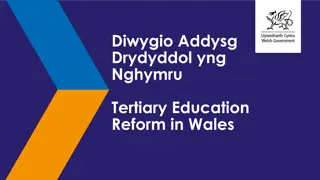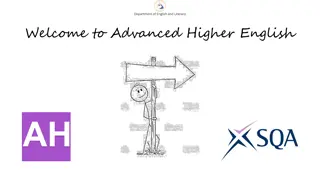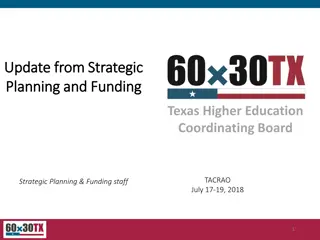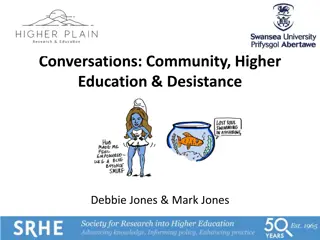Overview of Changes in English Higher Education Sector
Overview of the privatisation, changes to student support, financialisation of university finances, and debt implications in the English Higher Education sector. It covers aspects like marketisation, external privatisation, student loan changes, and the influx of private capital. The overview also discusses the impact on student finances, maintenance support, fee-loan regimes, and loan issuance trends.
Download Presentation

Please find below an Image/Link to download the presentation.
The content on the website is provided AS IS for your information and personal use only. It may not be sold, licensed, or shared on other websites without obtaining consent from the author.If you encounter any issues during the download, it is possible that the publisher has removed the file from their server.
You are allowed to download the files provided on this website for personal or commercial use, subject to the condition that they are used lawfully. All files are the property of their respective owners.
The content on the website is provided AS IS for your information and personal use only. It may not be sold, licensed, or shared on other websites without obtaining consent from the author.
E N D
Presentation Transcript
English HE an overview 6 February 2016 Andrew McGettigan andrewjmcgettigan@gmail.com @amcgettigan
Overview Privatisation Changes to Student Support Loans Financialisation University Finances Debt Conclusion
An articulated concept PRIVATISATION
1. Marketisation or external privatisation new operations with different corporate forms are allowed to enter the system to increase competition dissolving the distinction between separate public and private sectors. But also establishment of new market conditions. Uncapping of sector and institutions for undergraduate recruitment. 2. Commodification the presentation of higher education as solely a private benefit to the individual consumer; even as a quasi-financial asset where the return on investment is seen in higher future earnings. 3. Independence from regulation also regulation as means to break up public sector monopoly . 4. Internal privatisation changes to revenue streams within institutions so that for example, direct public funding is replaced by private tuition fee income. We could add to this list: 5. The outsourcing of jobs and activities to the private sector and management consultants, which has become widespread in England. 6. Changes to the corporate form and governance structures of universities. 7. The entry of private capital and investment into the sector through buyout and joint ventures. Complexity cannot be left to journalists to unpick it.
Consensus on fee-loan regime for full-time study Maintenance support is adequate (or parents & family contribute to make up shortfall?) Rents in London Students also take out commercial debt with more onerous repayment terms Overdrafts, bank loans, credit cards, payday loans ... More onerous repayment terms And take on excessive paid work in term time Graduate disposable income can support loan repayments without being burdensome Concurrency of PG loan repayment (15% above 21 000 threshold) SLC Scheme is fair and progressive But regular reviews of terms now promised that can retrospectively increase payments Freezing threshold takes more repayments from lower and middle earners
2019/20 2020/21 2015/16 2016/17 2017/18 2018/19 New loans issued 13.3 15.4 17.6 19.8 21.5 22.9 ( billion) Repayments 2.2 2.6 2.8 2.9 2.8 3.3 ( billion) 'Shortfall' - contribution to 11.2 12.8 14.8 16.9 18.7 19.6 PSNCR ( billion) Projected loan outlay & repayments - ENGLAND - cashflow ( billion) OBR, Economical & Fiscal Outlook November 2015
Putting Education into a system of accounts FINANCIALISATION
Small Business, Enterprise and Employment Act Royal Assent at the end of March 2015 Section 6 Evaluating Education [The measures] will also help to create an incentive and reward structure at universities by distinguishing the universities that are delivering the strongest enterprise ethos and labour market outcomes for their students. Conservative 2015 GE Manifesto: require more data to be openly available to potential students so that they can make decisions informed by the career paths of past graduates Green Paper, November 2015 Section 78 of the Small Business, Enterprise and Employment Act 2015 now enables higher education data to be linked [and published] with HMRC income and employment data, and DWP benefits data to inform understanding of the labour market outcomes of graduates. (fn. 22, p. 31)
Initial TEF metrics After informal discussions with the sector, we believe at present there are three common metrics (suitably benchmarked) that would best inform TEF judgements. We propose initially to base the common metrics on existing data collections: 1. Employment/destination from the Destination of Leavers from Higher Education Surveys (outcomes), and, from early 2017, make use of the results of the HMRC data match; 2. Retention/continuation from the UK Performance Indicators which are published by Higher Education Statistics Agency (HESA) (outcomes); 3. Student satisfaction indicators from the National Student Survey (teaching quality and learning environment). Green Paper, November 2015, Ch 3, paragraph 12
Announcement from HESA, Dec 2015 ... we are currently reviewing national requirements for information. Our aim is to replace the current Destination of Leavers from Higher Education (DLHE) survey, and the Longitudinal DLHE, in 2017. We aim to improve data quality and reduce the burden of collection, by linking to HMRC data made available under the Small Business, Enterprise and Employment Act. We will also utilise improved links back to our student data to enhance our understanding of the paths students take into and through study, and on to their next destination.
David Willetts Performance Indicators May 2012: I expect that, in the future, as the data accrue, the policy debate will be about the RAB charge for individual institutions the actual Exchequer risk from lending to students at specific universities. September 2012: Imagine that in the future we discover that the RAB charge for a Bristol graduate was 10 per cent. Maybe some other university we are only going to get 60 per cent back. Going beyond that it becomes an interesting question, to what extent you can incentivise universities to lower their own RAB charges. 16
Estimating the Human Capital of Graduates, Nuffield Foundation / IFS If different degrees from different institutions result in very different levels of earnings for students with similar pre-university qualifications and from similar socio-economic backgrounds, then this might affect both student choice and policies designed to increase participation and improve social mobility. http://www.nuffieldfoundation.org/estimating- human-capital-graduates
F.E.E.R. Future Earnings and Employment Record 19 June 2014 publication by Lord Young Enterprise for All Proposal to publish and index future employment and earnings data in a simple and accessible format so that students can assess the full costs and likely benefits of specific courses at specific institutions. 10 years post-completion [This data exists] Publishing this information through league tables would also promote competition and improvement amongst educators in their response to raising academic standards and their relevance to work and business.
Creditworthiness of individuals & institutions Milton Friedman: the [repayment demanded] should in principle vary from individual to individual in accordance with any differences in expected earning capacity that can be predicted in advance--the problem is similar to that of varying life insurance premia among groups that have different life expectancy. The Role of Government in Education That is, How much should this applicant from this district of this city with these qualifications be lent to do this course at this institution? What are they likely to repay? Good university - one that produces graduates able to repay more (and pay higher income tax) Graduate borrower is bearer of unit of account(ing)
Conclusion /discussion points TEF bureaucracy /workload vs ready-to-hand metrics Requiring data to be published /// using it in TEF to determine max fee Hard to argue that students shouldn t see earnings data of course graduates Higher fees unlikely without evidence of behavioural changes Institutional marking to cost-base Graduates less inactivity, more earnings in first 10 years of graduation Higher repayments creditworthiness Earnings data management paroxysms Sector Debt a long-term challenge brewing? Militant Research reading accounts, Freedom of Information requests, cataloguing the industry and business press for deals, financing and off-balance sheet activity, and so on. getting the truth out vs op-ed moralising Alternative models Part-time, lifelong, civic tertiary education Versus boarding school model 3 years away from home for 18 year-olds























